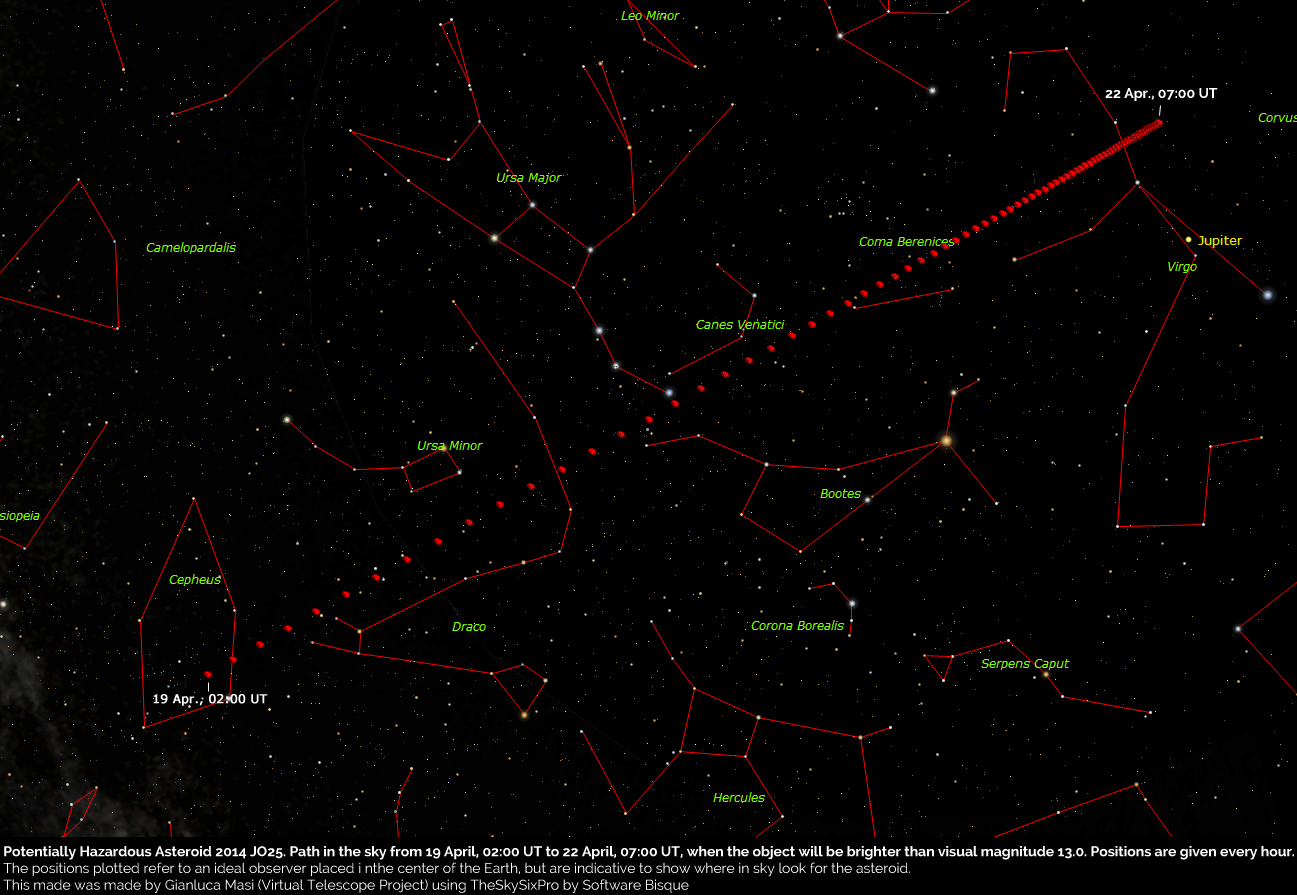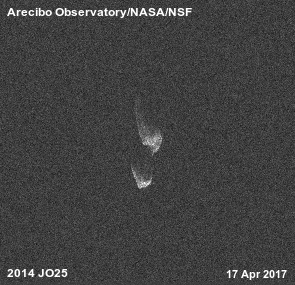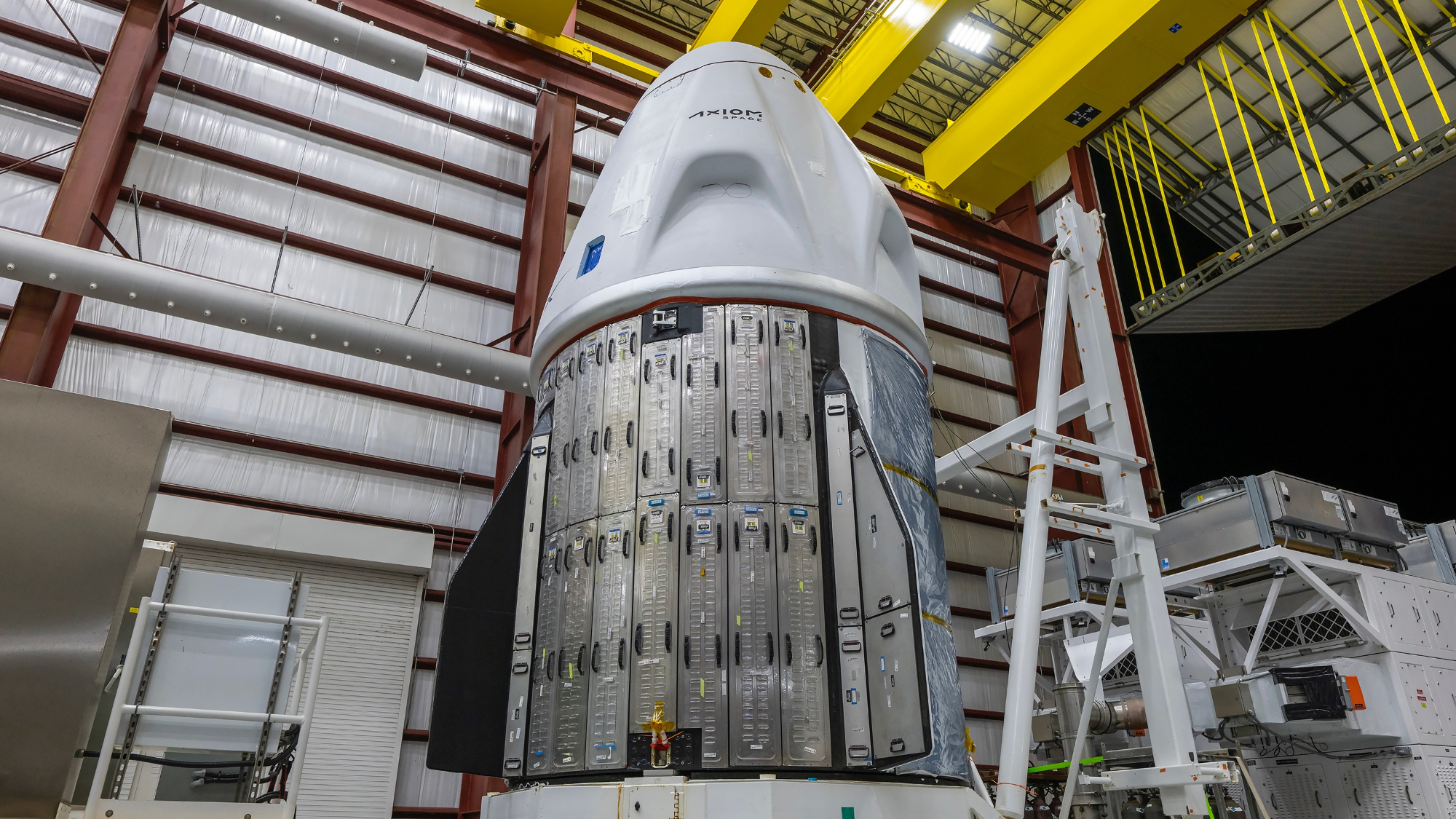Giant Peanut-Shaped Asteroid to Pass Harmlessly by Earth Wednesday

A huge, shiny, peanut-shaped asteroid will safely swing by Earth tomorrow morning (April 19), coming within a distance of 1.1 million miles (1.8 million kilometers) of the planet — about 4.6 times the distance from Earth to the moon.
The bright asteroid 2014 JO25 is coming toward Earth from the sun's direction and should be visible in the sky in small telescopes for a few days afterward as it fades from view. It will be at its closest point to Earth at 8:24 a.m. EDT (1224 GMT). You can see a video animation of the asteroid's orbit here.
Asteroid 2014 JO25 was first spotted in May 2014 by astronomers at the Catalina Sky Survey in Arizona, and measurements from NASA's NEOWISE mission suggested it was about 2,000 feet (650 meters) across, according to NASA's Jet Propulsion Laboratory (JPL). Radar observations from the Arecibo Observatory in Puerto Rico suggest it could be as big as 4,270 feet (1.3 km) at its widest point.
The asteroid's surface reflects about twice as much light as the moon. Its approach marks the closest an object this large has come to Earth since the gigantic asteroid 4179 Toutatis tumbled by in 2004, within 4 times the distance from the Earth to the moon.

Wednesday's approach is the closest 2014 JO25 has come in at least 400 years, and there's no known close approach coming through at least the year 2500. Although the asteroid's approach poses no risk to Earth — with a 0 percent impact probability — the International Astronomical Union's Minor Planet Center still classified it as "potentially hazardous" because of its size and nearness to Earth. Researchers will have to keep an eye on it to see if it drifts closer over the centuries, the Minor Planet Center wrote.
Astronomers around the world will study asteroid 2014 JO25 during and after its approach, including skywatchers at Arecibo and NASA's Goldstone Solar System Radar in California, JPL officials said in the statement — making observations that can potentially reveal features just a few meters across.
"Using radar, we can illuminate a near-Earth asteroid and directly measure its features,"astronomer Edgard Rivera-Valentín, a planetary scientist with the Universities Space Research Association (USRA) at the Arecibo Observatory, said in a separate statement. That's how scientists pinned down the asteroid's peanut shape, he added.
Get the Space.com Newsletter
Breaking space news, the latest updates on rocket launches, skywatching events and more!
The next close approach of a known giant asteroid will happen in 2027, when the half-mile-wide (800 m) asteroid 1999 AN10 passes by at about the distance from the Earth to the moon.

You can watch asteroid 2014 JO25's journey live on the Slooh online observatory's website starting at 7 p.m. EDT (2300 GMT) April 19, or on the Virtual Telescope Project's website starting at 3:30 p.m. EDT (1930 GMT). You can also seek it out in the sky using Virtual Telescope's celestial map, above, and a small telescope (although its position will vary, depending on your location).
While you're looking, keep an eye out for the comet PanSTARRS (C/2015 ER61), which will be visible in the dawn sky to observers with binoculars or a small telescope as it makes its closest approach of 109 million miles (175 million km).
Editor's note: If you capture a photo of asteroid 2014 JO25 through a telescope and would like to share it with Space.com, please send images and comments in to: spacephotos@space.com.
Correction: A previous version of this article incorrectly stated that the Arecibo Observatory is in Chile; it is Puerto Rico.
Email Sarah Lewin at slewin@space.com or follow her @SarahExplains. Follow us @Spacedotcom, Facebook and Google+. Original article on Space.com.
Join our Space Forums to keep talking space on the latest missions, night sky and more! And if you have a news tip, correction or comment, let us know at: community@space.com.

Sarah Lewin started writing for Space.com in June of 2015 as a Staff Writer and became Associate Editor in 2019 . Her work has been featured by Scientific American, IEEE Spectrum, Quanta Magazine, Wired, The Scientist, Science Friday and WGBH's Inside NOVA. Sarah has an MA from NYU's Science, Health and Environmental Reporting Program and an AB in mathematics from Brown University. When not writing, reading or thinking about space, Sarah enjoys musical theatre and mathematical papercraft. She is currently Assistant News Editor at Scientific American. You can follow her on Twitter @SarahExplains.
